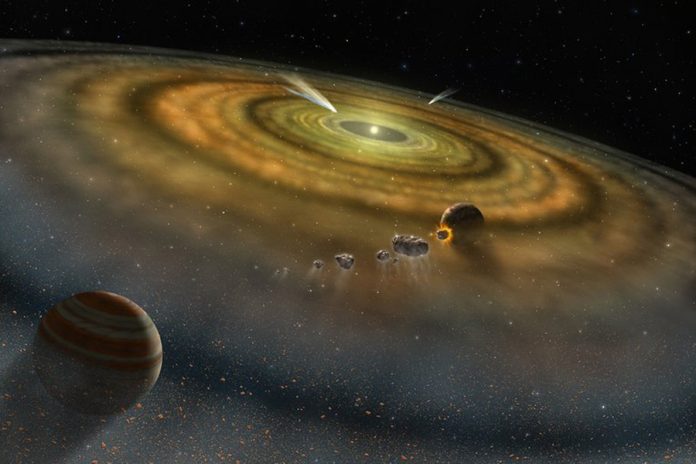
Tiny grains from the asteroid Ryugu are helping scientists uncover secrets about how the outer regions of our solar system formed over 4.6 billion years ago.
By studying these particles, researchers are beginning to understand the role of magnetic forces in shaping the distant parts of the solar system.
Collected by Japan’s Hayabusa2 mission, Ryugu samples were brought back to Earth in 2020.
Scientists think Ryugu formed on the far edges of the solar system before moving inward to the asteroid belt, eventually settling between Earth and Mars.
Analyzing these particles allows scientists to look back in time, offering clues about the magnetic environment where Ryugu first took shape.
A team led by researchers at MIT examined the particles from Ryugu to see if they showed signs of an ancient magnetic field. If such a field existed, it would have been weak, around 15 microtesla (for comparison, Earth’s magnetic field is about 50 microtesla).
Despite its weakness, this low-level magnetic field could still have been strong enough to pull together dust and gas to form asteroids in the outer solar system and may have even contributed to the formation of giant planets like Jupiter and Neptune.
This discovery, published in AGU Advances, is significant because it suggests that the outer solar system may have had a magnetic field, much like the inner solar system where Earth and the other rocky planets formed.
Previously, scientists knew that magnetic forces influenced the inner regions of the solar system, but they weren’t sure if this magnetic effect extended to the distant regions beyond Jupiter’s orbit. This new research suggests it did, although the magnetic field was much weaker.
Benjamin Weiss, an MIT professor and one of the study’s authors, explains, “We’re finding evidence that a magnetic field influenced mass distribution throughout the solar system, including the outer planets.” This magnetic field likely played a role in guiding matter, like gas and dust, toward areas where planets and other bodies eventually formed.
Lead author Elias Mansbach, now a postdoctoral researcher at Cambridge University, explains that the solar system formed from a dense cloud of gas and dust, which collapsed into a disk-like shape.
Most of this material gravitated toward the center, forming the sun, while the remaining particles became a swirling solar nebula. Interactions between the young sun and this ionized disk generated a magnetic field, which likely helped pull matter inward to create planets, moons, and asteroids.
This nebular magnetic field disappeared about 3 to 4 million years after the solar system’s formation. Scientists have evidence of this field’s presence in the inner regions, where it was strong—between 50 and 200 microtesla—but it wasn’t clear if it reached the outer solar system.
Until now, scientists couldn’t find many samples that might contain a record of this outer magnetic field.
The arrival of Ryugu samples provided a rare opportunity to explore the outer solar system’s magnetic history. Since Ryugu likely formed beyond 7 astronomical units (AU) from the sun (1 AU is the distance from the Earth to the sun), it may contain traces of the outer solar system’s magnetic field.
The MIT team used a device called a magnetometer to examine the particles from Ryugu. This instrument measures the strength and direction of magnetization within a sample.
By applying a changing magnetic field, the scientists could gradually erase any magnetization left in the sample, allowing them to “rewind” the sample’s magnetic history and see if it recorded an ancient magnetic field.
Their analysis found no clear evidence of a preserved magnetic field in Ryugu’s particles. This suggests that either no magnetic field was present where Ryugu formed, or that any field present was very weak. The team estimates that if there was a magnetic field, it would have been no stronger than 15 microtesla.
To confirm these findings, the team also reexamined other meteorites, specifically ungrouped carbonaceous chondrites, which may have formed in the outer solar system. By studying the ages of these samples, the researchers found that one sample likely recorded a faint magnetic field around 5 microtesla, supporting their estimate of a weak outer solar system field.
Together, the Ryugu particles and the meteorite samples suggest that a weak magnetic field likely extended to the solar system’s distant regions, influencing the early formation of outer bodies like Jupiter and Neptune. “Even a weak field can go a long way in the outer solar system,” notes Weiss.
Looking ahead, the researchers are eager to analyze samples from another distant asteroid, Bennu, brought back by NASA’s OSIRIS-REx mission in September 2023. Mansbach says, “Bennu looks similar to Ryugu, and we’re excited to see what those samples will reveal.”
This research, funded partly by NASA, opens a new window into understanding the solar system’s magnetic history and how it shaped the formation of planets and other celestial bodies.
Source: MIT.



